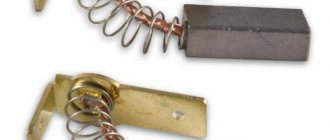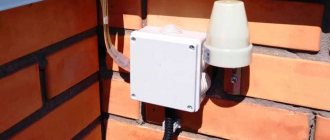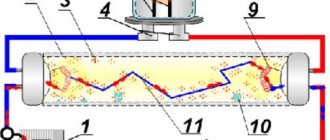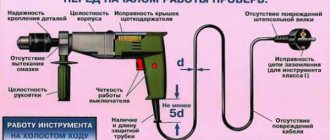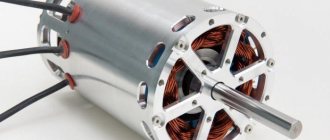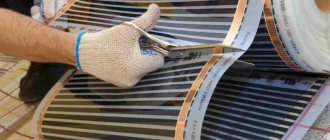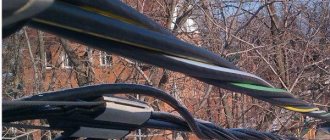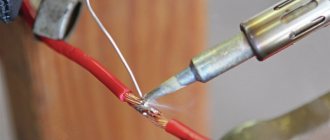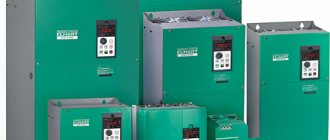Brushes for electrical machines: simple technology and universal application
Electric brushes are special electrically conductive parts of a current collecting device that are used to supply current to the commutators and slip rings of electric rotating machines.
Electric brushes are often used in DC electric machines, the switching conditions of which are quite difficult and there is a tendency to operate under a pronounced uneven load. Electric brushes are often used in small-sized universal motors with a high number of revolutions, as well as in crane motors. EG electric brushes are simply irreplaceable in auxiliary electric machines of railway rolling stock.
Electrographite brushes EG are made from a special mixture of graphite, carbon black and the necessary binders. The technology itself is relatively simple; upon completion, the electric brushes are fired. Electric brushes are mainly composed of ordinary graphite and the necessary binding materials. Often, EG electric brushes find their application in various DC electric machines, in high-power current generators, in welding-type generators, single-phase and multiphase commutator motors, as well as universal commutator motors, in rolling machine systems, tools and electrical household appliances for various purposes.
Electrographite electric brushes EG are subjected to special heat treatment in specialized furnaces at high temperatures (up to 2500 C). Electric brushes can be marked as follows: EG4, EG8, EG2a, etc.
The procedure itself, in which EG electric brushes are subjected to high-temperature thermal treatment, is called graphitization.
It is possible to purchase EG electric brushes of the required markings - the product range always allows customers to find exactly what they need. All products offered by the company have supplier certificates and are widely used in various areas of industry and everyday life, and their cost will certainly pleasantly surprise you.
Brushes are classified depending on the materials used and the characteristics of the technological process. They are divided into three groups:
Instructions for making electric brushes for a Makita hammer drill
As you know, the main source of a hammer drill is brushes. It is important to monitor their condition and the cleanliness of the collector. Makita 2450 and 2470 rotary hammers use carbon brushes CB-419 art. 191962-4. Factory carbon brushes are recommended to be replaced after 80 hours of operation. Both brushes must be replaced, regardless of the degree of wear.
Signs of brush wear
Do not confuse the usual small sparking that is present when working with partial sparks jumping around in a circle; this is acceptable under load and the brushes of a new tool have not yet gotten used to it.
The first signs of brush wear are strong sparking and extraneous sound. Stop working immediately!
Timely replacement of carbon brushes prevents failure of more expensive parts of the hammer drill.
The cost of a set of carbon brushes is not comparable to the cost of the rotor or stator of any power tool. You should not save on little, so as not to lose more.
The conclusion is simple: change your carbon brushes more often. Do not forget that if one brush malfunctions, the other should be changed automatically.
The critical length of the carbon brushes of a Makita rotary hammer cannot be less than 8 mm
When replacing, it is worth taking a closer look at the armature and what the output of the collector is. If there is a noticeable depression, the commutator should be ground to a smooth state; if this is not done, even the original new brushes will spark, which will lead to even greater burnout of the commutator.
After installing new brushes, be sure to let them grind in at idle speed without load for at least 10 minutes.
Set of new carbon brushes Makita 2450 and 2470
The procedure for performing work on the production of carbon brushes from other brushes
Carbon brushes can be purchased at almost any power tool store. But there are times when there is no store nearby, but you need to work.
There is a solution: you need to make brushes yourself from brushes from other power tools. An important point is the selection of an electric brush that is similar in its characteristics.
An incorrectly selected carbon rod will result in severe sparking or armature wear.
Option for homemade carbon brushes for the Makita 2470 rotary hammer
The manufacturing process of carbon brushes for a Makita rotary hammer
The work begins with the preparatory stage. It is necessary to select the correct cross-section of the carbon rod blank. Here are the dimensions of the factory carbon brushes CB-419A in mm (6x9x12). The selected carbon rods must have a cross-section larger or the same size as those used in Makita rotary hammers.
If you have selected workpieces of a larger cross-section, they are filed with needle files or sandpaper. But you can use a fairly simple device.
A special device called a “fungus” is clamped into an electric drill. Almost every master has this device. It is used in the process of grinding surfaces.
Brush Contact Selection
The most important thing when selecting electric motor brushes is to know the parameters of the used brushes. In addition to geometric dimensions, the new brush must match the grade of graphite, type and cross-section of wire. It is not necessary to take the same brand as the original, but the hardness of the electric motor brush and operating modes must match. The thickness of the wire should not be less than the original, and the flexibility should be consistent. Main mistakes when selecting a brush contact:
- Installing a harder graphite contact where softer ones were used. The result can be rapid wear of the manifold.
- Installation of “universal” brushes everywhere. This may interfere with the operation of the device.
- When purchasing a brush, focus on the graphite markings on the side of the old electric motor brush. Marking graphite is not marking contact parameters!
Replacing power tool brushes
In our imperfect world, nothing is eternal - and how evil this truism wanted to be confirmed while I was working as an angle grinder: a bright glow began to break through the body in the area where the brushes were located - this means the resource of these same brushes has come to an end and, accordingly, they need to be replaced. By chance, the emergency happened right at the end of the work and there was no need to urgently look for a replacement for the failed tool.
Still, the work associated with cutting various types of stone, facing tiles, concrete and the like made itself felt: even the venerable DeWalt did not last even three years - no matter how you protect the tool, air with abrasive particles passes as a coolant through the insides of the grinder , and since the brushes are made of pressed graphite, the material is quite soft - it “eats” it first. I reassured myself that brushes are almost consumables and replacing them won’t hurt my pocket at all. Disappointment came when, after scouring the Internet for about an hour, I found the brushes I needed only in one store in Odessa, and only after calling the next morning this store, the consultant finished me off, saying that the product I needed was not in stock and would not be at least until next year for sure.
Realizing that there was no way out, and a working grinder was needed tomorrow, it was decided to “put your hands in” and show Russian ingenuity.
First, I had to disassemble the grinder and remove what was left of the brushes for inspection and drawing conclusions.
By the way, DeWalt has a very thoughtfully made case: the compartment for brushes and buttons (by the way, dust-proof) stands apart and by unscrewing 4 screws, only the compartment itself opens, and the armature and everything else is in its own case.
The brushes are fixed in spring-loaded brush holders; and not in brass glasses, like the best examples of the Chinese industry. To ensure that the spring does not rest against the manifold slats during repairs or maintenance, parking pins are provided (seen in the photo).
I remove the brushes directly with the holders: inside one you can see a hole and a spring in it - something tells me this is a kind of wear indicator. When the spring rubs against the commutator, it produces a sheaf of sparks, thereby indicating the need to replace the brushes themselves.
By the way, I did not find any defects on the collector from this signaling mechanism.
The other brush is slightly livelier - such uneven production is due to the position of the brushes relative to the jet of air-abrasive mixture flying out of the working area.
I take the brushes out of the holders, measure them with a caliper and look in the treasured box with assorted parts for brushes that are at least remotely acceptable in size. These were found quite quickly. The only difference was in size (on the larger side, of course) and in the location of the contact wire output.
The required size was obtained by finishing the donor with a flat file and sandpaper with a grit of about 150; the originals also had a small sample on the bottom, which was filed with the same file.
Through constant fittings between graphite slaughters, I achieved an excellent fit of the donor brushes in the holders; In order for the contact wire coming out of the wrong place to allow the brush to sit completely in the socket, a groove was cut with a round needle file into which the wire settled.
Well, the brushes are inserted into the holders, and the brush holders are installed in their places: now you need to somehow connect the wires coming out of the brushes to the corresponding terminals.
I’ll be honest: I didn’t come up with anything better and cut off the wires from the old brushes and soldered them with the wires of the new ones - yes, I agree this is not correct - the soldering in this place is not very good, but I didn’t really have any options: the wires, as you can see, are short everywhere and will get unscrewed There was no other way.
Yes, and I tinned it efficiently and soldered it conscientiously - in general: it won’t come off - good; comes off - then we will think. The main thing is that after assembly the DeWalt started working. I didn’t observe any sparks from under the new brushes, the sound of the tool was smooth and without complaints, and tomorrow the new brushes will be tested while cutting metal.
Thank you for your attention!
Source: https://www.yaprofi.net/replacement-of-brushes-of-the-electric-tool/
Great Encyclopedia of Oil and Gas
Page 1
Carbon-graphite brushes are made from graphite with the introduction of other carbon materials (coke, soot) and binders. These brushes have increased mechanical strength, hardness and low wear during operation. [2]
| A brush on the slip ring of an electric machine. [3] |
Carbon-graphite brushes are made from graphite with the introduction of other carbon materials (coke, soot) and binders. Carbon-graphite brushes have increased mechanical strength, hardness and low wear during operation. [4]
| A brush on the slip ring of an electric machine. [5] |
Carbon-graphite brushes are made from graphite with the introduction of other carbon materials (coke, soot) and binders. Carbon-graphite brushes have increased mechanical strength, hardness and low wear during operation. [6]
Carbon-graphite brushes (grades G20, G21, G22) are made from graphite with the addition of coke, soot and binders and, after heat treatment, are coated with a thin layer of copper. They are designed for a nominal current density from 10 to 22 A/cm2, have increased mechanical strength, hardness and high wear resistance. [7]
Carbon-graphite brushes are made from a mixture of coke, carbon black, small amounts of graphite and binders. The technological process of their production ends with the firing operation. Graphite brushes are mainly composed of natural graphite and binder materials, and their production process also ends with a firing operation.
Electrographitized brushes differ from previous ones in that they undergo an additional heat treatment operation in special electric furnaces at a temperature of about 2500 C.
Metal-graphite brushes consist of metal powders, graphite and binders, and when the copper content is 90%, binders are not used. [8]
Carbon-graphite brushes are used for commutator machines with a power above 200 kW at a voltage of up to 1000 V and a quiet load, graphite brushes for commutator machines with a power of up to 10 kW at a voltage of up to 500 V and a quiet load, electrographite brushes are used for commutator machines of medium and high power at voltages up to 1000 V for medium and difficult switching conditions, copper-graphite brushes - for low-voltage DC generators with voltages up to 48 V and for slip rings of AC machines. [9]
Carbon-graphite brushes are used for commutator machines with a power above 200 kW at voltages up to 1000 V and a quiet load, graphite brushes are used for commutator machines with a power of up to 10 kW at voltages up to 500 s and a quiet load, electrographite brushes are used for commutator machines of medium and high power at voltages up to 1000 V for medium and difficult switching conditions, copper-graphite brushes - for low-voltage DC generators with voltages up to 48 V and for slip rings of AC machines. [10]
Why do brushes spark in an electric motor?
Sparks, including on a working engine, appear due to mechanical action between the brushes and the commutator. The brush, moving along the commutator from one of its contacts to another, alternately forms and breaks a connection with each of them. Now remember what happens if you unplug any working electrical appliance from the socket - usually at such a moment a spark jumps between the plug and the socket. In the case of a brushed motor, this is the same phenomenon.
Read also: Wrench for grinder dimensions
Therefore, a small spark even on a working electric motor is acceptable, since connections and ruptures constantly occur here.
How to replace drill brushes
While carrying out construction work, you notice that the power of the drill has dropped. The first thing a person thinks about is that they will have to spend money on a new purchase. However, most often the reason is in the brushes, which need to be replaced.
What is a brush
The brush of an electric drill is the part of the circuit that conducts the current to turn on the electric motor. There are several types of brushes, the main ones are graphite, round carbon and carbon-graphite brushes.
Graphite brushes have a long service life, but since graphite is a very hard material, lapping is not ideal and the commutator may be damaged. Carbon brushes do not last long, but have perfect contact with the commutator.
When is it time to change brushes?
When performing household work, the service life of brushes is achieved on average 80-120 hours. However, it is pointless to keep track of the drill’s operation, so it would be important to use a special brush wear indicator if the tool is not equipped with automatic shutdown when worn.
You can tell that the brushes are worn out even when using a top model. The first reason is a large number of sparks that occur in the collector area during operation. The power of the drill also decreases, the tool simply does not gain momentum, and the quality of work is lost.
If you remove the brushes, you can notice the wear with the naked eye, and both drill brushes are replaced, even if they are worn unevenly.
Replacing brushes involves thoroughly cleaning the commutator from carbon deposits and graphite dust that has settled during operation. Cleaning is carried out with gasoline or ethyl alcohol.
To reduce sparking, it is necessary to rub the brush against the commutator; for this, fine-grained sandpaper is used, which smoothes out irregularities on the surface of the brush.
When replacing brushes, you need to take into account the degree of hardness of the brush and the commutator itself. If the commutator is hard, then it is not advisable to install soft carbon brushes on it, which will wear out too quickly. Therefore, it is best to purchase brushes from the tool manufacturer itself.
Particular attention should be paid to the brush holder assembly, which consists of a contact, a clamping device and a profile. If the condition of the clamping device springs looks unreliable, it is better to replace them. A loose spring can lead to sparking, which will cause wear on the commutator plates, and if it bounces off, it can lead to serious repair work on the power tool.
Replacing the brushes yourself or seeking the help of a specialist is a purely individual matter. However, servicing a drill at a service center is not a cheap pleasure, so many craftsmen have gotten used to replacing the brushes themselves.
Source: https://rusveter.ru/rubrika_37/kak-zamjenit-shhjetki-drjeli.html
Causes of malfunctions and replacements
The role of brushes in an electric motor is undeniable. Therefore, it is advisable to minimize the influence of factors that lead to their malfunction.
In particular, the danger is caused by the phenomenon of sparking brushes. It manifests itself for the following reasons:
- Carbon deposits and dirt on the collector. It needs to be cleaned using a fine sandpaper.
- Accumulation of graphite dust or copper powder causing shorted contacts. It is advisable to quickly remove all jumpers using a knife or other sharp part.
- If the contacts differ in resistance level, or the brushes are incorrectly selected according to the main parameters, then this can cause sparking. In this case, you will need to replace the brushes for electric motors yourself or contact a service center.
- Complete resource depletion. This will also require replacing the brushes.
- Short circuit in the interturn section of the armature windings - to correct the situation, it is necessary to check the operability of the armature and change it if necessary.
Even if the brushes are selected correctly, it is recommended to take time to grind them in. To do this, it is advisable to run the engine idle without loading it. Also, the collector must be cleaned regularly, and the use of special lubricants will help extend the service life of the entire structure.
What are brushes for power tools and what are they for?
Not a single builder can carry out all the required construction work without the use of special power tools, which any person involved in construction simply must have. After all, even if you want to quickly and efficiently drill the required hole in the wall or cut metal, it is possible only with the help of power tools.
And nowhere without brushes
All such power tools have a small electric motor installed, which powers the entire tool, making it ready for specific tasks. But in order for the electric motor to work flawlessly, it is equipped with special small graphite brushes made only from high-quality material.
And although their name is not at all impressive, they still play one of the main roles in the operation of the entire power tool. After all, they are the ones who transmit electricity to the rotor, which is why rotation ultimately occurs.
Therefore, in the manufacture of graphite brushes, only metal that is suitable for some important parameters is used.
The metal must not only conduct electricity well, but also have sufficient hardness; if the metal is soft, then in the presence of constant friction, it will quickly become unusable.
Carbon brushes meet all these criteria. But in addition to these advantages, they have an equally interesting feature: quite often during operation of such an engine, a voltage arc appears between the contacts. At such moments, carbon brushes are not welded to the metal, which is why basically only this type of brush continues to be popular among various builders.
All power tools assembled by different manufacturing plants have from the very beginning conventional brushes that do not have the characteristics required for regular construction work. The poor quality of such brushes immediately becomes visible when the power tool is used for a long time.
Even a short-term heavy load on a power tool that has cheap brushes installed can result in breakdown, which will mainly be associated with the brushes.
And although even such a breakdown will not bring any joy, nevertheless, in the event of such a breakdown, the repair of the power tool takes place quickly enough and it can be performed without the involvement of a specialist.
Brush design.
The design of the brush indicates the location of the current-carrying leads on the body of the brush, their number, as well as the presence or absence of various slots for attaching the brush.
Typical designs of electric contact brushes are shown in the table.
| General view of the brush | Brush type | Brief description and purpose of the brush. |
| K1 | Rectangular brush, unreinforced. Used in radial brush holders with springs of various designs | |
| K1-1 | The brush is rectangular with one wire on the top surface along the axis of the brush. Used in radial brush holders with springs of various designs | |
| K1-2 | The brush is rectangular with one wire on the top surface, offset from the axis of the brush. Used in radial brush holders with springs of various designs | |
| K1-3 | The brush is rectangular with two wires on the top surface, symmetrical relative to the axis of the brush. Used in radial brush holders with springs of various designs | |
| K1-4 | The brush is rectangular with one wire on the smaller side edge. Used in radial brush holders with springs of various designs | |
| K1-5 | The brush is rectangular with one wire on the larger side edge. Used in radial brush holders with springs of various designs | |
| K1-6 | The brush is rectangular with two wires on the side. Used in radial brush holders with springs of various designs | |
| K1-7* | The brush is rectangular with two wires on the top surface, offset from the axis of the brush. Used in radial brush holders with springs of various designs | |
| K1-8* | The brush is rectangular with four wires on the top surface, symmetrical relative to the axis of the brush. Used in radial brush holders with springs of various designs | |
| K2 | Brush with beveled contact surface. Used in reactive brush holders | |
| K2-1 | A brush with a beveled contact surface and one wire on the upper surface of the brush along the axis of the brush. Used in reactive brush holders | |
| K2-2 | A brush with a beveled contact surface and one wire on the upper surface of the brush, offset from the axis of the brush. Used in reactive brush holders | |
| K2-3 | A brush with a beveled contact surface and two wires on the upper surface of the brush, symmetrical relative to the axis of the brush. Used in reactive brush holders | |
| K2-7* | A brush with a beveled contact surface and two wires on the upper surface, offset from the axis of the brush. Used in reactive brush holders | |
| K2-8* | A brush with a beveled contact surface and four wires on the top surface, symmetrical relative to the axis of the brush. Used in reactive brush holders | |
| K3-3 | A brush with beveled contact and top surfaces and two wires on the top surface. Used in reactive brush holders | |
| K3-5 | A brush with beveled contact and top surfaces with a wire on the side edge. Used in reactive brush holders | |
| K3-8* | Brush with beveled contact and top surfaces and four wires on the top surface. Used in reactive brush holders | |
| K4-2 | The brush is rectangular with a bevel on the top surface and one wire on the bevel. Used in radial brush holders with springs of various designs | |
| K5-2 | A brush with a beveled contact surface and one wire on the beveled top surface. Used in reactive brush holders | |
| K6-3 | The brush is rectangular with bevels on the top surface and two wires on the bevels. Used in radial brush holders with springs of various designs | |
| K6-8* | The brush is rectangular with bevels on the top surface and four wires on the bevels. Used in radial brush holders | |
| K8 | The brush is rectangular with a groove on the top surface. Used in radial brush holders | |
| K8-2 | The brush is rectangular with a groove and one wire on the top surface, offset from the axis of the brush. Used in radial brush holders with flat band spring | |
| K8-3 | The brush is rectangular with a groove and two wires on the top surface, symmetrical relative to the axis of the brush. Used in radial brush holders with flat band spring | |
| K8-4 | The brush is rectangular with a groove on the top surface and one wire on the smaller side edge. Used in radial brush holders with flat band spring | |
| K8-5 | The brush is rectangular with a groove on the top surface and a wire on the larger side edge. Used in radial brush holders with flat band spring | |
| K8-8* | The brush is rectangular with a groove and four wires on the top surface, symmetrical relative to the axis of the brush. Used in radial brush holders with flat band spring | |
| K10-4 | A brush with a beveled contact surface, a groove on the top surface and one wire on the side edge. Used in reactive brush holders | |
| K11 | A brush with a beveled contact surface, a groove on the top surface and one wire on the side edge. Used in radial brush holders | |
| K11-3 | A brush with a beveled contact surface, a beveled groove and two wires on the top surface, symmetrical relative to the axis of the brush. Used in reactive brush holders | |
| K11-4 | A brush with a beveled contact surface, a beveled groove on the top surface and one wire on the side edge. Used in reactive brush holders | |
| K11-8 | A brush with a beveled contact surface, a beveled groove on the top surface and four wires on the top surface. Used in reactive brush holders | |
| K12-3 | Rectangular brush with a groove and two wires on the top surface, with a rubber pad. Used in radial brush holders | |
| K12-8* | Rectangular brush with a groove and four wires on the top surface, with a rubber pad. Used in radial brush holders | |
| K13-2 | The brush is rectangular with a groove on the top surface with a bevel and one wire on the bevel. Used in radial brush holders with flat band spring | |
| K14 | The brush is rectangular with a head on the top surface. Used in radial brush holders with spiral wire spring | |
| K14-1 | The brush is rectangular with a head on the top surface and one wire on the head. Used in radial brush holders with spiral wire spring | |
| K14-5 | The brush is rectangular with a head on the top surface and one wire on the side. Used in radial brush holders with spiral wire spring | |
| K15-6 | Brush with contact and top surfaces, with a beveled groove and two wires in the side face. Used in reactive brush holders | |
| K16-2 | A brush with a beveled contact surface, two bevels on the top surface and one wire on the bevel. Used in reactive brush holders | |
| K17-2 | A brush with a beveled contact surface, two bevels on the top surface and one wire in the side bevel. Used in reactive brush holders | |
| K17-3 | A brush with a beveled contact surface, three bevels on the top surface and two wires in the side bevels. Used in reactive brush holders | |
| K18-2 | A brush with a beveled contact surface, two bevels, a beveled groove on the top surface and one wire on the bevel. Used in reactive brush holders | |
| K19-2 | A brush with a beveled contact surface, three bevels, a beveled groove on the top surface and one wire on the bevel. Used in reactive brush holders | |
| K20-3 | The brush is split with bevels on the contact and top surfaces, a pressed-in cover and two wires offset relative to the axis of the brush. Used in reactive brush holders | |
| K20-8 | The brush is split with bevels on the contact and top surfaces, a pressed-in patch and four wires. Used in reactive brush holders | |
| K21-2 | Brush of complex design with one wire. Used in radial brush holders | |
| K21-3 | Brush of complex design with two wires. Used in radial brush holders | |
| K22-6 | The brush is rectangular with two bevels, a groove on the top surface and two wires on the side. Used in radial brush holders with flat band spring | |
| K23-1 | Trapezoidal brush with one wire. Used in radial brush holders | |
| K23-8 | Trapezoidal brush with four wires. Used in radial brush holders | |
| K24-2 | A brush with bevels on the contact and top surfaces, a beveled groove and one wire on the bevel. Used in reactive brush holders | |
| K27-3 | Trapezoidal brush with two wires. Used in radial brush holders | |
| K27-8 | Trapezoidal brush with four wires. Used in radial brush holders | |
| K28-3 | A brush with a complex contact surface and two wires symmetrical relative to the axis of the brush. Used in radial brush holders |
